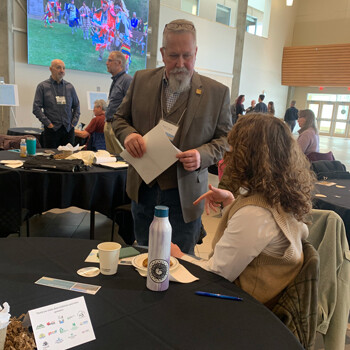(Re)connecting to the Biosphere and to Each Other

Relationships are central to the principles of the Beaver Hills Biosphere – relationships between organizations, residents, researchers, government, board and staff, but also our respective relationships to the Beaver Hills – the land, its history and its future.
That in mind, on March 1 – 2, 2023, the Biosphere held its inaugural open house and forum at the Strathcona County Centre to not only showcase the important work and research underway in the Biosphere, but to also reestablish old and develop new relationships between people and this important region.
“This was our first large-scale event post-COVID and the first time we’ve been able to provide an in-person opportunity for people to hear about the interesting and important work our partners are doing in the area,” says Brian Ilnicki, Executive Director of the Beaver Hills Biosphere.
“It was important to reconnect with partners and the community and celebrate all that the Biosphere is. The conversations and connections made at an in-person event just can’t be replicated online.”
For the more than 100 attendees, the open house and forum was an exciting opportunity to deepen their connection to what makes the Beaver Hills special and broaden their understanding of the significance of the work underway in the Biosphere.
Covering topics ranging from stewardship and sustainable development to wetland management to Indigenous involvement in the Biosphere and more, speakers represented a variety of important Biosphere interests: biodiversity, cultural diversity, planning and economic development, and research and education. With researchers, artists, film makers, planners and other professionals, municipal representatives and community members and more in attendance, the open house and forum demonstrated how much depth there is to the Biosphere and the breadth of people’s connections to this landscape.
“The Biosphere represents a multi-dimensional approach to stewardship and we rely on diverse experiences, education, wisdom and perspectives to help it thrive,” explains Brian. “It’s important we not only promote the work of organizations that support conservation and stewardship in the Beaver Hills, but that we also raise awareness of the many cultural, economic and social elements of the landscape.”
Brian adds that he hopes participants left feeling energized and part of the Biosphere’s work – and they did. Whether they have long been involved in the Biosphere or just learned about it for the first time, attendees said they found the event and Biosphere approach inspiring.
“There’s a need to continue cultivating bioregional identity and a deep stewardship culture in the Beaver Hills. I felt so inspired to do more!” one participant says.
“The work you folks are doing is crucial to evolving the culture in that area towards improved stewardship and community,” another participant says. “I’m so grateful for what you all do.”
Dr. Guy Swinnerton, a key figure in early efforts of the Beaver Hills Initiative, and who was instrumental in the subsequent establishment of the Beaver Hills Biosphere, offered this about the event, “I think that events such as these are absolutely essential for the on-going success of the Beaver Hills Biosphere. Although [it] is part of an internationally recognized global network, its success and contribution to testing approaches to sustainable development, that have global as well as local relevance, is ultimately dependent on local community involvement and engagement…”
Another participant summed it up particularly well, saying, “Get out of your house and learn about where you live.”
Above all, attendees left with a better understanding of the Biosphere as a learning place for sustainable development, an appreciation for how important the collaborative nature of the Biosphere is to its success and an opportunity to see themselves as part of this lived-in and working landscape.
Check out these summaries of the speakers’ presentations.